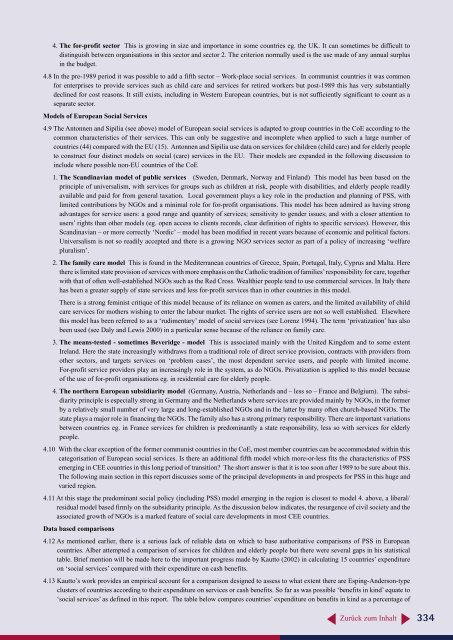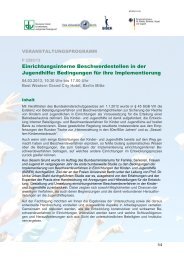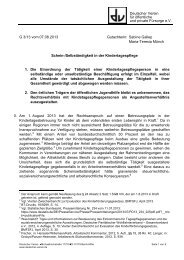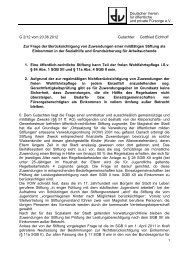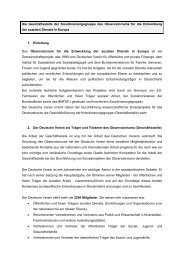Workshop 1.6 - Deutscher Verein für öffentliche und private Fürsorge
Workshop 1.6 - Deutscher Verein für öffentliche und private Fürsorge
Workshop 1.6 - Deutscher Verein für öffentliche und private Fürsorge
Sie wollen auch ein ePaper? Erhöhen Sie die Reichweite Ihrer Titel.
YUMPU macht aus Druck-PDFs automatisch weboptimierte ePaper, die Google liebt.
4. The for-profit sector This is growing in size and importance in some countries eg. the UK. It can sometimes be difficult to<br />
distinguish between organisations in this sector and sector 2. The criterion normally used is the use made of any annual surplus<br />
in the budget.<br />
4.8 In the pre-1989 period it was possible to add a fifth sector – Work-place social services. In communist countries it was common<br />
for enterprises to provide services such as child care and services for retired workers but post-1989 this has very substantially<br />
declined for cost reasons. It still exists, including in Western European countries, but is not sufficiently significant to count as a<br />
separate sector.<br />
Models of European Social Services<br />
4.9 The Antonnen and Sipilia (see above) model of European social services is adapted to group countries in the CoE according to the<br />
common characteristics of their services. This can only be suggestive and incomplete when applied to such a large number of<br />
countries (44) compared with the EU (15). Antonnen and Sipilia use data on services for children (child care) and for elderly people<br />
to construct four distinct models on social (care) services in the EU. Their models are expanded in the following discussion to<br />
include where possible non-EU countries of the CoE<br />
1. The Scandinavian model of public services (Sweden, Denmark, Norway and Finland) This model has been based on the<br />
principle of universalism, with services for groups such as children at risk, people with disabilities, and elderly people readily<br />
available and paid for from general taxation. Local government plays a key role in the production and planning of PSS, with<br />
limited contributions by NGOs and a minimal role for for-profit organisations. This model has been admired as having strong<br />
advantages for service users: a good range and quantity of services; sensitivity to gender issues; and with a closer attention to<br />
users’ rights than other models (eg. open access to clients records, clear definition of rights to specific services). However, this<br />
Scandinavian – or more correctly ‘Nordic’ – model has been modified in recent years because of economic and political factors.<br />
Universalism is not so readily accepted and there is a growing NGO services sector as part of a policy of increasing ‘welfare<br />
pluralism’.<br />
2. The family care model This is fo<strong>und</strong> in the Mediterranean countries of Greece, Spain, Portugal, Italy, Cyprus and Malta. Here<br />
there is limited state provision of services with more emphasis on the Catholic tradition of families’responsibility for care, together<br />
with that of often well-established NGOs such as the Red Cross. Wealthier people tend to use commercial services. In Italy there<br />
has been a greater supply of state services and less for-profit services than in other countries in this model.<br />
There is a strong feminist critique of this model because of its reliance on women as carers, and the limited availability of child<br />
care services for mothers wishing to enter the labour market. The rights of service users are not so well established. Elsewhere<br />
this model has been referred to as a ‘rudimentary’ model of social services (see Lorenz 1994). The term ‘privatization’ has also<br />
been used (see Daly and Lewis 2000) in a particular sense because of the reliance on family care.<br />
3. The means-tested - sometimes Beveridge - model This is associated mainly with the United Kingdom and to some extent<br />
Ireland. Here the state increasingly withdraws from a traditional role of direct service provision, contracts with providers from<br />
other sectors, and targets services on ‘problem cases’, the most dependent service users, and people with limited income.<br />
For-profit service providers play an increasingly role in the system, as do NGOs. Privatization is applied to this model because<br />
of the use of for-profit organisations eg. in residential care for elderly people.<br />
4. The northern European subsidiarity model (Germany, Austria, Netherlands and – less so – France and Belgium). The subsidiarity<br />
principle is especially strong in Germany and the Netherlands where services are provided mainly by NGOs, in the former<br />
by a relatively small number of very large and long-established NGOs and in the latter by many often church-based NGOs. The<br />
state plays a major role in financing the NGOs. The family also has a strong primary responsibility. There are important variations<br />
between countries eg. in France services for children is predominantly a state responsibility, less so with services for elderly<br />
people.<br />
4.10 With the clear exception of the former communist countries in the CoE, most member countries can be accommodated within this<br />
categorisation of European social services. Is there an additional fifth model which more-or-less fits the characteristics of PSS<br />
emerging in CEE countries in this long period of transition? The short answer is that it is too soon after 1989 to be sure about this.<br />
The following main section in this report discusses some of the principal developments in and prospects for PSS in this huge and<br />
varied region.<br />
4.11 At this stage the predominant social policy (including PSS) model emerging in the region is closest to model 4. above, a liberal/<br />
residual model based firmly on the subsidiarity principle. As the discussion below indicates, the resurgence of civil society and the<br />
associated growth of NGOs is a marked feature of social care developments in most CEE countries.<br />
Data based comparisons<br />
4.12 As mentioned earlier, there is a serious lack of reliable data on which to base authoritative comparisons of PSS in European<br />
countries. Alber attempted a comparison of services for children and elderly people but there were several gaps in his statistical<br />
table. Brief mention will be made here to the important progress made by Kautto (2002) in calculating 15 countries’ expenditure<br />
on ‘social services’ compared with their expenditure on cash benefits.<br />
4.13 Kautto’s work provides an empirical account for a comparison designed to assess to what extent there are Esping-Anderson-type<br />
clusters of countries according to their expenditure on services or cash benefits. So far as was possible ‘benefits in kind’ equate to<br />
‘social services’ as defined in this report. The table below compares countries’ expenditure on benefits in kind as a percentage of<br />
Zurück zum Inhalt<br />
334


